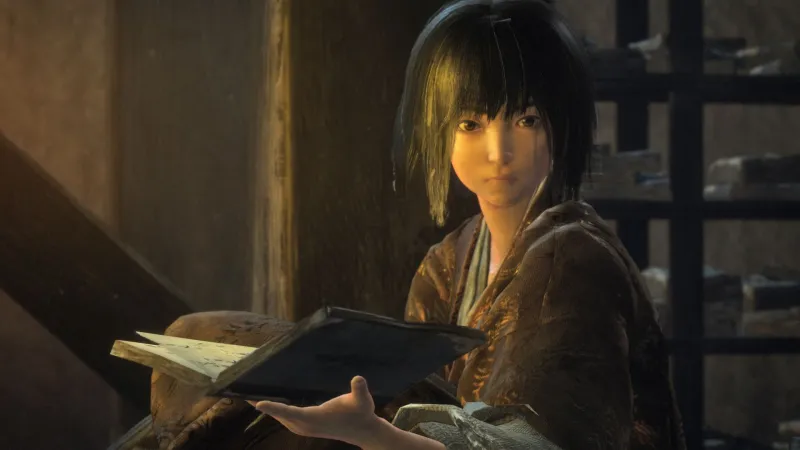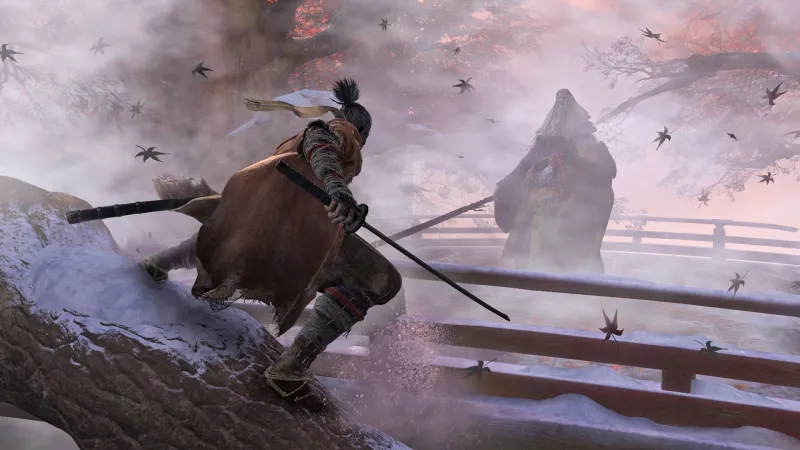


Set in the waning years of Sengoku-era Japan, Sekiro: Shadows Die Twice features a brighter, more colorful world than we’ve seen out of From Software. This lets them create environments with a different air about them than either Bloodborne or Dark Souls, as the developer tries to both elicit and play with the beauty of Japan during the Warring States period. The change in locale has also prompted From Software to make some key changes to how it tells stories, but it’s not shying away from the key methods fans have come to love.
For starters, don’t let the brighter environments in Sekiro fool you into thinking this will be a cheerier tale. “Of course, this being a From title, there’s beauty and there’s death and decay to contrast that,” says From manager of marketing and communications Yasuhiro Kitao. When choosing a time period for Sekiro, From chose the earlier Sengoku era over the more modern Edo period as its setting specifically because it fit the studio’s style. “Edo is more like Japan coming back from the brink, and really kind of revitalizing itself, and everything’s a lot more early-modern [stuff],” Kitao says. “Sengoku is much like Dark Souls and such, more medieval Japan, and allows us to play with those medieval concepts and those more mystical concepts.”
The company has taken inspiration from history before (the company looked to Victorian London when making Bloodborne), and you can expect a similar approach to Japan in Sekiro. “We decided to take inspiration from the architecture and the vegetation, but there are no actual historical people or locations featured in the game,” Kitao says. “This is a From game we’re talking about. It’s a Miyazaki game we’re talking about. You can probably expect a lot of weirdness to occur and to begin to unravel as you progress through the game.”
With its move away from RPG builds and progression, From is also leaning into telling the story of a set character rather than letting players create their own. Previous From games told the story of their worlds moreso than any individual character, delving into the history of the locations you traversed and telling stories of characters whose footsteps you were following. While your character in those games set important events in motion, you were only one small part of a grander tale. “This time we have a fixed protagonist and we have a cast of characters who we’re trying to build that story around,” Kitao says. “We’re trying to tell more of a drama, if you will, of these characters.”

The story of Sekiro begins with the Young Lord, a child The Wolf is in charge of protecting. Early in the game, The Wolf and the Young Lord are assaulted by a group of enemies led by the Ashina Commander, who defeats The Wolf, chops off his arm, and kidnaps the Young Lord. After finding himself restored to health after the battle and wearing a prosthetic limb, The Wolf’s goal at the start of Shadows Die Twice is to find and retrieve the Young Lord – and exact revenge on his assailant.
“One nice thing about basing the story around these characters is we get to play with the relationship between these characters, between [The Wolf] and the Young Lord, and how their relationship kind of evolves throughout the game,” Kitao says. The Young Lord and The Wolf will meet up several times throughout the story, and the story will place a large emphasis on their relationship. “There is one point in the early game where he is by your side, but this is not a kind of escort mission in the typical sense, and it only happens the one time.”
The Wolf is also a more fleshed-out character than the player characters in other From games. Raised on the battlefield by a character named The Owl, The Wolf will speak to other characters as he encounters them, lending his own character to the story. “Having this key protagonist allows us to build a cast of characters around him, and his personality, and his history,” says director Hidetaka Miyazaki. “We feel like, you know, not the typical NPCs that you run into during the game, but these kind of central – these core characters that are central to his presence in the world, and his story – are going to be playing a lot of that role of the story in the gameplay. So, we feel like you’ll be able to experience both his past, in that sense, and the here-and-now of where the game takes place.”

The main area we played through, the Hirata Estates, was couched in the story as a flashback, in which The Wolf fights against Lady Butterfly, an acquaintance of The Owl. “He sort of plays a foster father role to the protagonist,” Miyazaki says. “This Owl character picked up Sekiro on the battlefield and raised him as a shinobi and one of his old acquaintances – or part of that shinobi system of allies – was this Lady Butterfly character. So, while Owl was training the protagonist and teaching him techniques, maybe he got to spar with this character or had some sort of menial relationship with her through the foster-father figure.”
From isn’t going to lean too heavily on flashbacks to tell its story, however. “It’s mainly focused on the present,” Miyazaki says. “It’s not a game where you’re going back and forth from present to past to piece together the puzzle, but this is a one-off flash back, if you will, to a portion of his past and that allows you to piece a little more bits together of the story. So, you get some extra detail and you can flesh things out for yourself in that way.”
While this more character and narrative-centric approach is atypical for From, Kitao is confident with how the change in direction is taking shape. “It's actually a very 'From’ way of doing a protagonist, and the way he conducts himself and the way this character kind of evolves is very kind of From-esque," he says. Although he’ll have a central role in the story, don’t expect Sekiro to be a chatterbox. “He'll say a few things here and there, but yeah, he won't bore you to tears with constant monologues," Kitao says.
At first, this character-driven approach seems to clash with one of From’s signature storytelling techniques: foregoing a traditional narrative in favor of having players build their own narrative out of vague hints from characters and item descriptions. From is well aware of fans’ love of that technique, and wants to assure them what while the story they’re telling is angled differently, the methodology isn’t changing too much. “That is very much intact in Sekiro, we’re trying to maintain that,” Kitao says. "We don't want to rob the experience of that kind of fragmented storytelling. We want it to be a user-driven story, a play-driven experience rather than [something] directed by us. We don't want to feed the user every little bit of information. We don't want to tell them straight-up the answers, or how something is. We'd like them to experience and explore that for themselves."

We found plenty of items during our time with Sekiro, and of course the descriptions for these items were more than just functional. The description for the Fistful of Ash item, for example, states it can be thrown to distract enemies, but also mentions that doing exactly that was a hobby of boys growing up in Ashina, the locale in which The Wolf was raised. As we approached a particular area, we also saw a scene of the Young Lord chatting with Emma (one of the characters who helps you in Sekiro’s hub area) play out through ghostly figures in the environment itself, similar to how certain “flashbacks” in games like BioShock occur. However, Kitao says the number of cutscenes in Sekiro won’t be out of line with the company’s past work, and that they won’t have huge info dumps, either. “We want users to pick up on these subtle hints through the cutscenes, through the dialogue, as well."
That said, From is making some changes to this storytelling approach - namely, who’s doing the telling. Although Miyazaki is handling the overall story, he won’t be doing the bulk of the writing for the dialogue and item descriptions, delegating the job to other members of the staff to “create a fresh experience and something that we hope users have never seen before,” Kitao says. Miyazaki himself doesn’t want to fall back into his old writing tricks, either, something he feels fans wouldn’t be as excited about as they have been in the past.
While Miyazaki finds the change refreshing in some ways, it’s meant getting used to a change in the overall narrative workflow. “Previously, I could have just written some stuff down as part of the text or dialog at home,” Miyazaki says. “Nowadays, for Sekiro I have to communicate this to staff and be really quite forthcoming about it. That’s quite tough in itself. But then to see them reinterpret this into their idea of what that means or that implies, this is enlightening for me, and it allows me to see this different interpretation and then to have this collaborative story building together.” This, in turn, gives Miyazaki the ability to see the story From is building from a new perspective, and for the first time, get a read on how coherent it might be to an outside reader.
Sekiro: Shadows Die Twice makes a number of tweaks to how From Software tells stories, but from the time we’ve spent with it, it looks to stay true to the company’s mantra of letting players engage with their stories in various engaging ways, even as it aims to tell a more personal tale.
For more on Shadows Die Twice: check out our deep dive into a boss fight, how progression works, and more, and make sure to click on the hub below to follow our coverage all throughout the month.


Explore your favorite games in premium print format, delivered to your door.